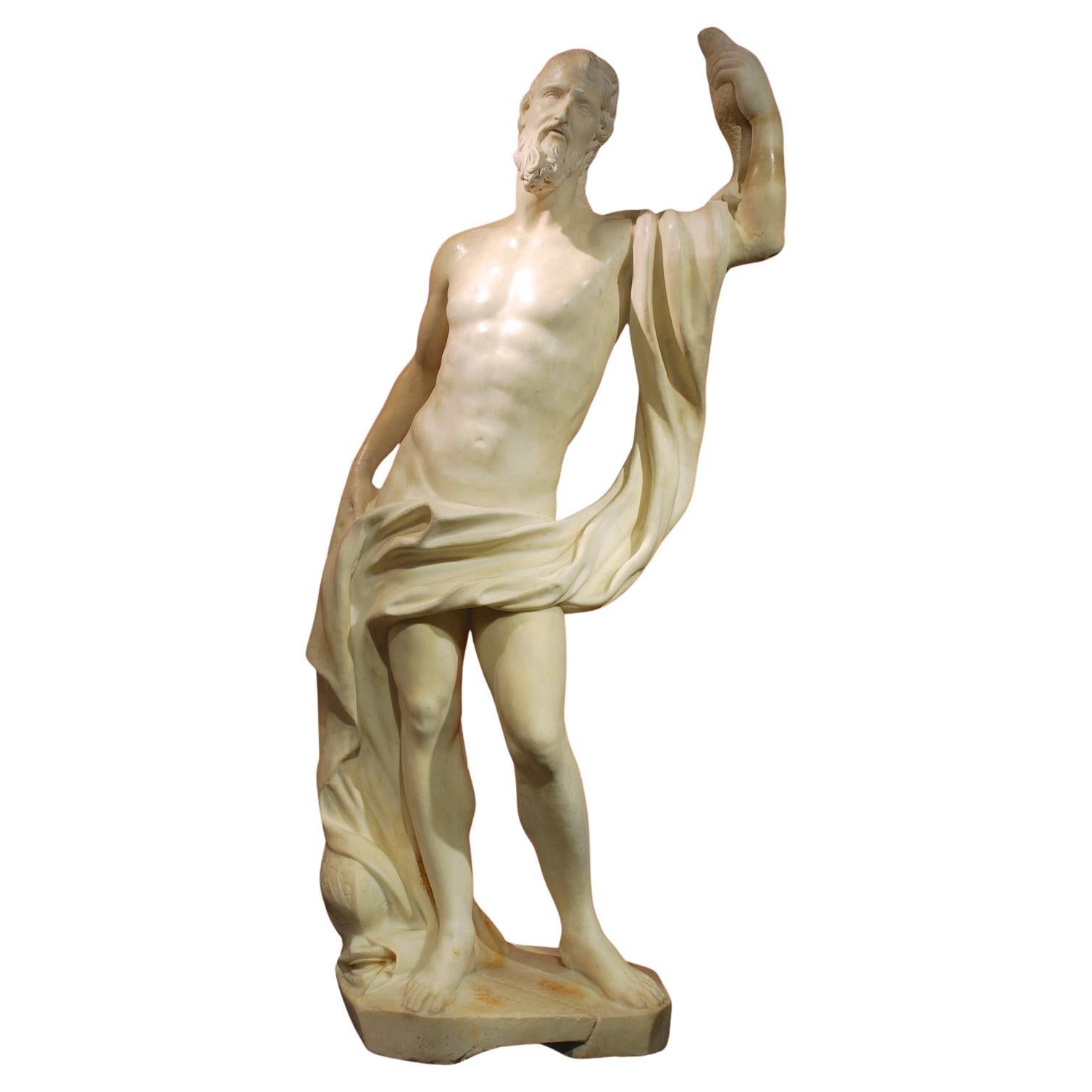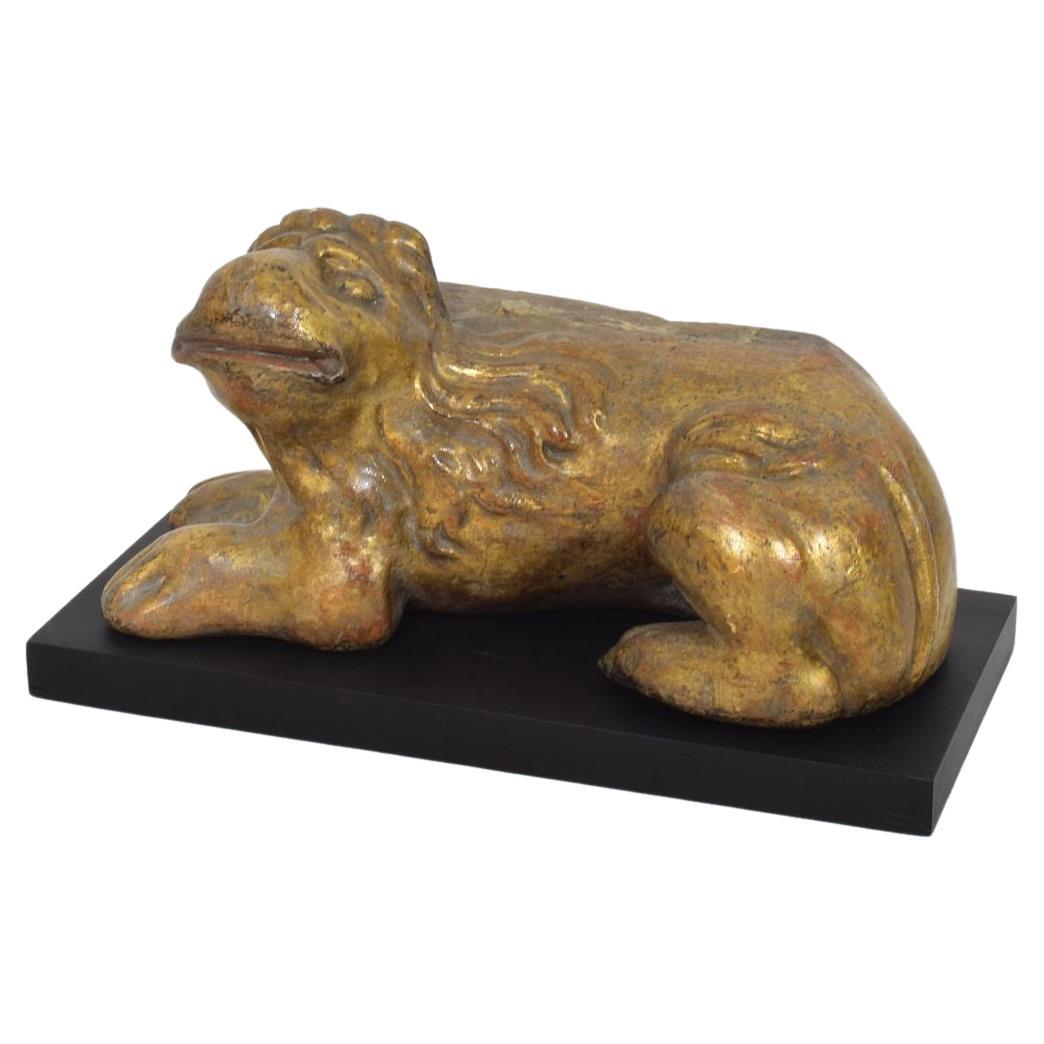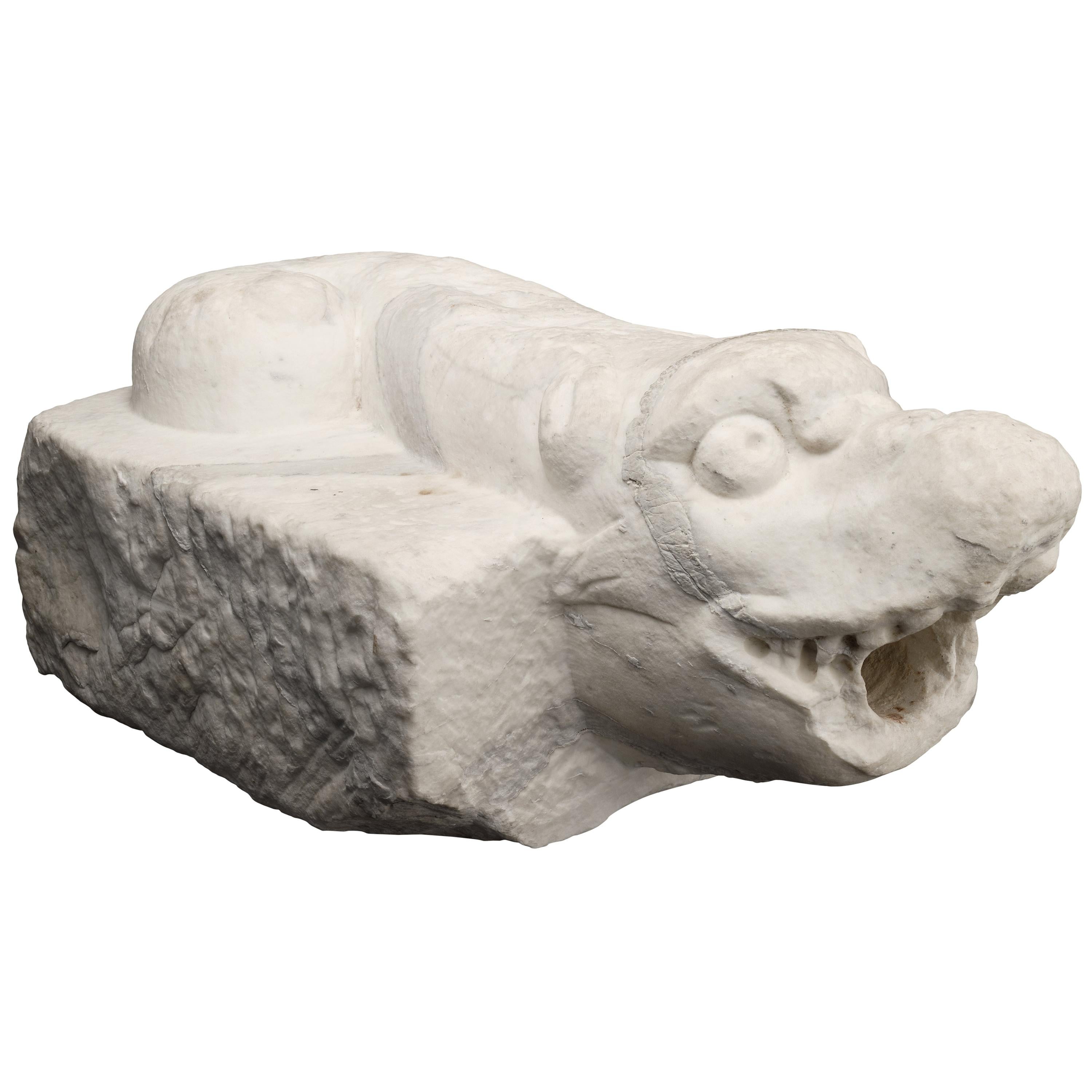Items Similar to Carved and Mounted Marble Stemma Cartouche from Tuscany, Italy, 16th Century
Want more images or videos?
Request additional images or videos from the seller
1 of 15
Carved and Mounted Marble Stemma Cartouche from Tuscany, Italy, 16th Century
About the Item
The carvings of this marble stemma cartouche dates to the 1500’s. Hand-carved in Tuscany, Italy, the marble was mounted onto a geometrically shaped iron stand within the last century.
Stemmas can be traced back to ancient Rome when genealogical information was recorded on scrolls. In the Middle Ages, coat of arms began to replace stemmas as the preferred method for conveying familial lines. An oval escutcheon surrounded by scrolls is depicted on the 16-inch-tall marble. The shield has a sinister bend emblazoned with fluting. There are two floral rosette charges, one on each side of the bend. The left side of the marble has a large “Z” and a floral rosette amongst geometric carvings. Our Italian 16th century carved marble stemma cartouche can be displayed indoors or outside.
- Dimensions:Height: 21 in (53.34 cm)Width: 23.25 in (59.06 cm)Depth: 8.75 in (22.23 cm)
- Materials and Techniques:
- Place of Origin:
- Period:
- Date of Manufacture:1500s
- Condition:Additions or alterations made to the original: The iron stand was added by a previous owner. Wear consistent with age and use. Minor losses. Very good antique condition with fleabites and buildup to marble. The stand, which was added more recently, has minor rubs and oxidation to the iron. The marble has developed a weathered gray patina. Please see photos for details.
- Seller Location:Dallas, TX
- Reference Number:
About the Seller
5.0
Platinum Seller
These expertly vetted sellers are 1stDibs' most experienced sellers and are rated highest by our customers.
Established in 1983
1stDibs seller since 2011
738 sales on 1stDibs
Typical response time: <1 hour
- ShippingRetrieving quote...Ships From: Dallas, TX
- Return PolicyA return for this item may be initiated within 2 days of delivery.
More From This SellerView All
- 15th or 16th Century Marble Gargoyle Fountain Spout from Arezzo, ItalyLocated in Dallas, TXAlthough when most people hear the word “gargoyle”, they probably envision small, winged creatures with grotesque visages. However, the phrase has a deeper meaning, encompassing any carved head (animal or human) that function as waterspouts. From the Early Renaissance (late 1400’s/early 1500’s), our gargoyle fountain spout features a human-like face with pointed ears, possibly representing a centaur or a satyr. The roughly rectangular block of marble was hand-carved in Arezzo, in the Tuscany region of Italy. All sides except the front of the cream-colored stone have a sawed finish, resulting in a rough texture. The back has been excavated, adding to the character of the gargoyle. A 1 ½” diameter hole has been cut all the way through, forming an open mouth of the gargoyle. The gaping mouth was often a symbol used to conjure images of devouring giants and used to remind people that they are susceptible to certain forces. Our 15th/16th century marble...Category
Antique 16th Century Italian Renaissance Fountains
MaterialsMarble
- 17th Century Italian Carved Marble Bust on Iron Stand from the Amalfi CoastLocated in Dallas, TXSalvaged from a villa on the Amalfi Coast in Southern Italy, this beautiful marble bust was hand-carved in the 1600’s. Our subject has a cloak wrapped around his shoulders and is depicted looking slightly to his left and upwards. The bust sits atop a classically inspired iron Stand with a large circular base (held into place with a bolt system). Resembling a Corinthian order column, the Stand has been embellished with a fluted column with an acanthus capital. With an excavated back and weathered patina, our 17th century Italian bust was originally part of a larger outdoor sculpture installation. Some old Italian residences (such as Villas Cimbrone...Category
Antique 17th Century Italian Busts
MaterialsMarble, Iron
- Large Early 18th Century Carved Giltwood Cherub Statue from ItalyLocated in Dallas, TXThis Italian giltwood cherub carving from the early 1700s is in great condition for its age. Standing at over three feet tall, the statue is qu...Category
Antique Early 18th Century Italian Figurative Sculptures
MaterialsWood, Giltwood
- Pair of 18th Century Carved Wooden Winged Cherubs from ItalyLocated in Dallas, TXOriginally from 18th-century Italy, this pair of winged cherubs were hand-carved from wood as reflections of each other, meaning that their bodies are orientated as mirror images. Bo...Category
Antique 18th Century Italian Figurative Sculptures
MaterialsWood, Paint
- Pair Carved and Mounted Giltwood Ornaments, Italy C. 1850Located in Dallas, TXHand-carved in Italy, circa 1850, this pair of carved giltwood ornaments have been mounted to a painted black stand with thin metal supports more recently. The foliate ornaments cons...Category
Antique Mid-19th Century Italian Mounted Objects
MaterialsMetal
- Carved Limestone Horsehead from ItalyLocated in Dallas, TXHand-carved by an Italian stone mason, this quaint limestone horsehead has excellent proportions. The contour of the cheek, the thick mane, and the slightly open mouth give the head a sense of realism. Carved with amazing precision, the horse can stand upright (face up) without the aid of a stand. Of course, it can also be hung on a wall in the proper orientation. Decorative horse heads of this size were often seen hanging on the exterior wall of a horse barn.Category
21st Century and Contemporary Italian Garden Ornaments
MaterialsLimestone
You May Also Like
- A 16th century carved marble sculpture of poseidonLocated in London, GBThis fine and imposing sculpture is an excellent example of 16th century Italian craftsmanship. The figure is stood on a raised, shaped rectangular base with a carved "dolphin" at th...Category
Antique 16th Century Italian Renaissance Figurative Sculptures
MaterialsMarble
- Italian 16th century Hand Carved Wooden LionLocated in Buisson, FRUnique period piece. Extremely rare 16th century Italian hand carved lion. Most likely once part of a piece of furniture. Beautifully carved in a simple folk art way with traces of i...Category
Antique 16th Century Italian Folk Art Figurative Sculptures
MaterialsWood
- Italian 16th century Hand Carved Wooden LionLocated in Buisson, FRUnique period piece. Extremely rare 16th century Italian hand carved wooden lion. Most likely once part of a piece of furniture. Beautifully ca...Category
Antique 16th Century Italian Figurative Sculptures
MaterialsWood
- Misericord. Carved wood. 16th century.Located in Madrid, ESChoir Mercy. Carved wood. Century XVI. Carved wooden Misericordia that surely belonged to a choir stall (see the upper flat part, which acts as a seat), decorated with a figurative ...Category
Antique 16th Century European Renaissance Figurative Sculptures
MaterialsOther
- Angel, Carved and Polychrome Wood, 16th CenturyLocated in Madrid, ESAngel. Carved and polychrome wood. Century XVI. Polychrome wood carving showing an angel, with the face facing the viewer and the body in pr...Category
Antique 16th Century Spanish Renaissance Figurative Sculptures
MaterialsWood
- Italian Ancient Marble Sculpture Fountain, Late 16th CenturyLocated in Milano, ITSea monster Carrara marble mouth fountain Italy, late 16th century It measures 13.8 x 31.5 x 18.9 in (35 x 80 x 48 cm) State of conservation: some small evident gaps and widespread signs of wear due to outdoor exposure. The gray marks crossing it do not come from restoration, but are rather the natural veins of the marble. This work has some morphological characteristics typically associated with the iconography of the sea monster: an elongated muzzle, sharp teeth, protruding eyes, elongated ears, and a coiled serpent's tail. An in-depth series of studies on artistic depictions of the sea monster attempted to verify how this symbol evolved in antiquity in the European and Mediterranean contexts and how it gradually changed its image and function over time. The iconography itself is mutable and imaginative and its history is rich with cultural and artistic exchange, as well as the overlapping of ideas. This occurred so much that it is difficult to accurately pinpoint the "types" that satisfactorily represent its various developments. However, we can try to summarize the main figures, starting from the biblical Leviathan and the marine creature that swallowed Jonah (in the Christian version, this figure was to become a whale or a "big fish", the “ketos mega”, translation of the Hebrew “dag gadol”). Other specimens ranged from the dragons mentioned in the Iliad (which were winged and had legs) to "ketos” (also from Greek mythology), the terrifying being from whose Latinized name (“cetus”) derives the word "cetacean". See J. Boardman, “Very Like a Whale” - Classical Sea Monsters, in Monsters and Demons in the Ancient and Medieval Worlds, in Papers presented in Honor of Edith Porada, Mainz am Rhein 1987, pp. 73-84). In Italy the monster underwent yet further variations: it can be found in Etruscan art on the front of some sarcophagi representing the companion of souls, while among the Romans we find the “Pistrice” (cited by Plinio in Naturalis Historia PLIN., Nat., II 9, 8 and by Virgilio in Eneide: VERG., Aen., III, 427), which appeared in the shape of a stylized hippocampus or a very large monstrous cetacean and evolved into a hideous being with a dragon's head and long webbed fins. During the Middle Ages, the sea monster was the object of new transformations: at this time, it is often winged, the head is stretched like a crocodile, the front legs are often very sharp fins - sometimes real paws - until the image merges with dragons, the typical figures of medieval visionary spirituality widely found throughout Europe (on this topic and much more, see: Baltrušaitis, J., Il Medioevo fantastico. Antichità ed esotismi nell’arte gotica, Gli Adelphi 1997). In Italy during the 15th and 16th centuries, the revival of classicism - representative of the humanistic and Renaissance periods - led to a different reading of these "creatures". Indeed, the sea monster was also to find widespread use as an isolated decorative motif, especially in numerous fountains and sculptures where dolphins or sea monsters were used as a characterizing element linked to water (on this theme see: Chet Van Duzer, Sea Monsters on Medieval and Renaissance Maps, London, The British library, 2013). From the morphological point of view, the "sea monsters" of this period are mostly depicted as hybrid figures, in which the body of a mythological or real being (a hippocampus, a sea snake, a dolphin), is joined to a head with a rather indistinct appearance. It was usually characterized by large upright ears, an elongated snout, sharp teeth and globular, protruding eyes; a complex and indefinite figure, both from the symbolic point of view and from that of its genesis. The work we are examining is placed as a cross between the medieval sea serpent and the Renaissance dolphin, with stylistic features which recall the snake as often used in heraldry (such as the "snake" depicted in the coat of arms of the Visconti - the lords and then dukes of Milan between 1277 and 1447 - and which, for some, may be derived from the representations of the “Pistrice” that swallowed Jonah). In the search for sources, Renaissance cartography and in particular woodcuts should not be neglected. See for example the monsters of Olaus Magnus, from the editions of the “Historia de gentibus septentrionalibus” (“History of the peoples of the north”) and the natural histories of Conrad Gesner, Ulisse...Category
Antique 16th Century Italian Renaissance Animal Sculptures
MaterialsCarrara Marble
Recently Viewed
View AllMore Ways To Browse
Antique Cartouche
16th Italian
Carved Cartouche
Italy 16th Century
Tuscany Furniture
16th Century Italy Furniture
16th Century Italian Furniture
Italian Cartouche
Italian Marble Carving
Large Italian Marble Sculpture
Coat Of Arms Carved
Marble 16th
16th Iron
16th Century Iron
Tall Marble Sculpture
16th Century Italian Carved
Marble Display Stands
Large Marble Carving





